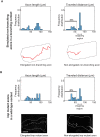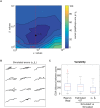A stochastic framework to model axon interactions within growing neuronal populations
- PMID: 30507939
- PMCID: PMC6292646
- DOI: 10.1371/journal.pcbi.1006627
A stochastic framework to model axon interactions within growing neuronal populations
Abstract
The confined and crowded environment of developing brains imposes spatial constraints on neuronal cells that have evolved individual and collective strategies to optimize their growth. These include organizing neurons into populations extending their axons to common target territories. How individual axons interact with each other within such populations to optimize innervation is currently unclear and difficult to analyze experimentally in vivo. Here, we developed a stochastic model of 3D axon growth that takes into account spatial environmental constraints, physical interactions between neighboring axons, and branch formation. This general, predictive and robust model, when fed with parameters estimated on real neurons from the Drosophila brain, enabled the study of the mechanistic principles underlying the growth of axonal populations. First, it provided a novel explanation for the diversity of growth and branching patterns observed in vivo within populations of genetically identical neurons. Second, it uncovered that axon branching could be a strategy optimizing the overall growth of axons competing with others in contexts of high axonal density. The flexibility of this framework will make it possible to investigate the rules underlying axon growth and regeneration in the context of various neuronal populations.
Conflict of interest statement
The authors have declared that no competing interests exist.
Figures







Similar articles
-
Discrete stochastic model for the generation of axonal trees.Annu Int Conf IEEE Eng Med Biol Soc. 2014;2014:6814-7. doi: 10.1109/EMBC.2014.6945193. Annu Int Conf IEEE Eng Med Biol Soc. 2014. PMID: 25571561
-
A developmental approach to predicting neuronal connectivity from small biological datasets: a gradient-based neuron growth model.PLoS One. 2014 Feb 21;9(2):e89461. doi: 10.1371/journal.pone.0089461. eCollection 2014. PLoS One. 2014. PMID: 24586794 Free PMC article.
-
Axon regrowth during development and regeneration following injury share molecular mechanisms.Curr Biol. 2012 Oct 9;22(19):1774-82. doi: 10.1016/j.cub.2012.07.044. Epub 2012 Aug 23. Curr Biol. 2012. PMID: 22921367
-
Intra-axonal protein synthesis in development and beyond.Int J Dev Neurosci. 2016 Dec;55:140-149. doi: 10.1016/j.ijdevneu.2016.03.004. Epub 2016 Mar 9. Int J Dev Neurosci. 2016. PMID: 26970010 Free PMC article. Review.
-
Mushroom body memoir: from maps to models.Nat Rev Neurosci. 2003 Apr;4(4):266-75. doi: 10.1038/nrn1074. Nat Rev Neurosci. 2003. PMID: 12671643 Review. No abstract available.
Cited by
-
Distinctive properties of biological neural networks and recent advances in bottom-up approaches toward a better biologically plausible neural network.Front Comput Neurosci. 2023 Jun 28;17:1092185. doi: 10.3389/fncom.2023.1092185. eCollection 2023. Front Comput Neurosci. 2023. PMID: 37449083 Free PMC article. Review.
-
The prion-like domain of Drosophila Imp promotes axonal transport of RNP granules in vivo.Nat Commun. 2019 Jun 13;10(1):2593. doi: 10.1038/s41467-019-10554-w. Nat Commun. 2019. PMID: 31197139 Free PMC article.
-
Cofilin regulates axon growth and branching of Drosophila γ-neurons.J Cell Sci. 2020 Apr 28;133(8):jcs232595. doi: 10.1242/jcs.232595. J Cell Sci. 2020. PMID: 32152181 Free PMC article.
-
BCNNM: A Framework for in silico Neural Tissue Development Modeling.Front Comput Neurosci. 2021 Jan 20;14:588224. doi: 10.3389/fncom.2020.588224. eCollection 2020. Front Comput Neurosci. 2021. PMID: 33551782 Free PMC article.
-
In silico framework to inform the design of repair constructs for peripheral nerve injury repair.J R Soc Interface. 2022 Mar;19(188):20210824. doi: 10.1098/rsif.2021.0824. Epub 2022 Mar 2. J R Soc Interface. 2022. PMID: 35232275 Free PMC article.
References
-
- Bixby JL, Harris WA. Molecular mechanisms of axon growth and guidance. Annual Review of Cell Biology. 1991;7:117–59. 10.1146/annurev.cb.07.110191.001001 - DOI - PubMed
-
- Tessier-Lavigne M, Goodman CS, et al. The molecular biology of axon guidance. Science. 1996;274(5290):1123–1133. 10.1126/science.274.5290.1123 - DOI - PubMed
-
- Song Hj, Poo Mm. The cell biology of neuronal navigation. Nature cell biology. 2001;3(3):E81–E88. 10.1038/35060164 - DOI - PubMed
-
- Dickson BJ. Molecular mechanisms of axon guidance. Science. 2002;298(5600):1959–1964. 10.1126/science.1072165 - DOI - PubMed
-
- Guan KL, Rao Y. Signalling mechanisms mediating neuronal responses to guidance cues. Nature Reviews Neuroscience. 2003;4(12):941–956. 10.1038/nrn1254 - DOI - PubMed
Publication types
MeSH terms
LinkOut - more resources
Full Text Sources
Molecular Biology Databases

